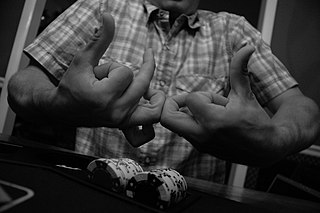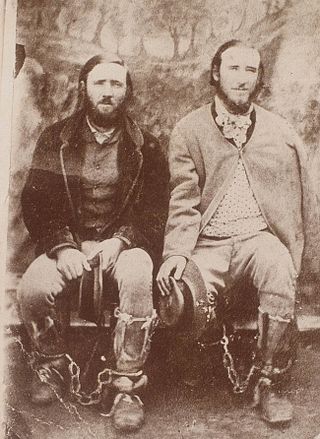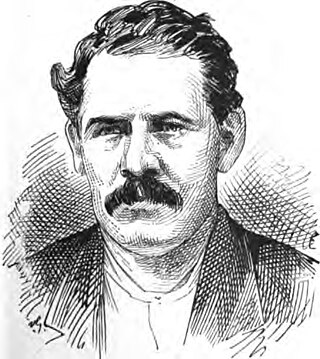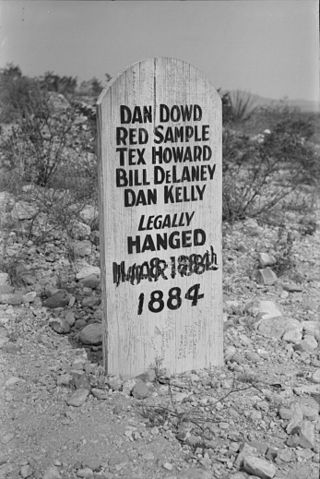
The Bloods are a primarily African-American street gang founded in Los Angeles, California. The gang is widely known for its rivalry with the Crips. It is identified by the red color worn by its members and by particular gang symbols, including distinctive hand signs.

Tiffany & Co. is a luxury jewelry and specialty design house, headquartered on Fifth Avenue in Manhattan. It sells jewelry, sterling silver, porcelain, crystal, stationery, fragrances, water bottles, watches, personal accessories, and leather goods. Tiffany is known for its luxury goods, particularly its diamond and sterling silver jewelry. These goods are sold at Tiffany stores, online, and corporate merchandising. Its name and branding are licensed to Coty for fragrances and to Luxottica for eyewear.
The Hudson Dusters was a New York City street gang during the early twentieth century.
The Cherry Hill Gang was a New York street gang during the late nineteenth century.
The Dutch Mob was a New York pickpocket gang during the late nineteenth century.

The Whyos or Whyos Gang, a collection of the various post-Civil War street gangs of New York City, was the city's dominant street gang during the mid-late 19th century. The gang controlled most of Manhattan from the late 1860s until the early 1890s, when the Monk Eastman Gang defeated the last of the Whyos. The name came from the gang's cry, which sounded like a bird or owl calling, "Why-oh!"

Brothers Thomas and John Clarke were Australian bushrangers from the Braidwood district of New South Wales. They committed a series of high-profile crimes which led to the enacting of the Felons' Apprehension Act (1866), a law that introduced the concept of outlawry in the colony and authorised citizens to kill bushrangers on sight. Thomas was proclaimed an outlaw on 31 May 1866.
The Irish Mob is a collective of organized crime syndicates composed of ethnic Irish members which operate primarily in Ireland, the United States, Canada and Australia, and have been in existence since the early 19th century. Originating in Irish-American street gangs – famously first depicted in Herbert Asbury's 1927 book, The Gangs of New York – the Irish Mob has appeared in most major U.S. and Canadian cities, especially in the Northeast and the urban industrial Midwest, including Boston, New York City, Philadelphia, Cleveland, Toronto, Montreal, Winnipeg, and Chicago.
"The Pie" is the 79th episode of the NBC sitcom Seinfeld. This was the 15th episode for the fifth season. It aired on February 17, 1994. The episode's main running theme is characters adamantly refusing to eat certain foods served to them without giving an explanation. A store mannequin that looks just like Elaine is also a focus in multiple plot threads of the episode.

The Young Savages is a 1961 American crime drama film directed by John Frankenheimer and starring Burt Lancaster. It was written by Edward Anhalt from a novel by Evan Hunter. The supporting cast includes Dina Merrill, Shelley Winters, and Edward Andrews, and The Young Savages was the first film featuring Telly Savalas, who plays a police detective, foreshadowing his later role as Kojak. Often categorized as a "thinking man's movie", it has received mixed reviews. Aspects of the film are inspired by the real-life Salvador Agron case.
The Yakey Yakes was a 19th-century street gang, prominent in New York's underworld during the late 1890s and early 1900s. Based in the neighborhood of Catherine and Madison Streets, the gang were formed by Yakey Yake Brady in the 1890s and later participated in the gang war between Monk Eastman and Paul Kelly.

The Bowery Boys were a nativist, anti-Catholic, and anti-Irish criminal gang based in the Bowery neighborhood of Manhattan, New York City in the early-mid-19th century. In contrast with the Irish immigrant tenement of the Five Points, one of the worst city slums in the United States, the Bowery was a more prosperous working-class community. Despite its reputation as one of the most notorious street gangs of New York City at the time, the majority of the Bowery Boys led law-abiding lives for the most part. The gang was made up exclusively of volunteer firemen—though some also worked as tradesmen, mechanics, and butchers —and would fight rival fire companies over who would extinguish a fire. The Bowery Boys often battled multiple outfits of the infamous Five Points, most notably the Dead Rabbits, with whom they feuded for decades. The uniform of a Bowery Boy generally consisted of a stovepipe hat in variable condition, a red shirt, and dark trousers tucked into boots—this style paying homage to their firemen roots.

Keep 'Em Slugging is a 1943 American film starring the Little Tough Guys and directed by Christy Cabanne for Universal Pictures. This was the final film in Universal's Little Tough Guys series, and although Universal still billed the group as "The Dead End Kids and The Little Tough Guys", none of the Little Tough Guys appeared in this film.
The Whittemore Gang was a group of bank robbers active in the Mid-Atlantic and Eastern United States during the mid-1920s. Led by Richard Reese Whittemore, the gang, including his wife Margaret, went on a year-long crime spree committing payroll, bank and jewelry robberies in Maryland and New York before their capture in 1926.

The Devil's Party is a 1938 American crime film directed by Ray McCarey based on the Borden Chase novel Hell's Kitchen Has a Pantry.

William O'Brien, better known as Billy Porter but also known by the alias William or Billy Morton, was an American burglar and underworld figure in New York City during the mid-to late 19th century. He and partner Johnny Irving were longtime members of the Dutch Mob along with Little Freddie and Michael "Sheeny Mike" Kurtz. He was present during the 1883 gunfight at Shang Draper's saloon in which Irving was shot and killed by rival John "Johnny the Mick" Walsh. O'Brien then killed Walsh and was himself gunned down by Shang Draper. Although surviving his wounds, he was tried for, and acquitted of, Walsh's death.

The Bisbee massacre occurred in Bisbee, Arizona, on December 8, 1883, when six outlaws who were part of the Cochise County Cowboys robbed a general store. Believing the general store's safe contained a mining payroll of $7,000, they timed the robbery incorrectly and were only able to steal between $800 and $3,000, along with a gold watch and jewelry. During the robbery, members of the gang killed five people, including a lawman and a pregnant woman. Six men were convicted of the robbery and murders. John Heath, who was accused of organizing the robbery, was tried separately and sentenced to life in prison. The other five men were convicted of murder and sentenced to hang.

David Thai,, is a Vietnamese-born American gangster who was the founder and leader of the notorious Born to Kill gang during the late 1980s and early 1990s. He was also responsible for running a massive illegal counterfeit watch operation and at his peak controlled the market and distribution of counterfeit watches in New York by means of blackmail and extortion. He was the official leader of Born to Kill from 1988 until his arrest in 1991, which was the combination of months of investigation by the United States Bureau of Alcohol, Tobacco, Firearms and Explosives (ATF) in conjunction with the aid of a former gang member who defected from the gang and became an undercover informant, helping secure the convictions of David Thai and several of his high-ranking officers.
There's That Woman Again is a 1938 American comedy mystery film directed by Alexander Hall. It is the sequel to There's Always a Woman, released the same year. In both films, Melvyn Douglas stars as a private investigator whose wife involves herself in his work. Joan Blondell played the wife in the first film, but that role went to Virginia Bruce in this one.










